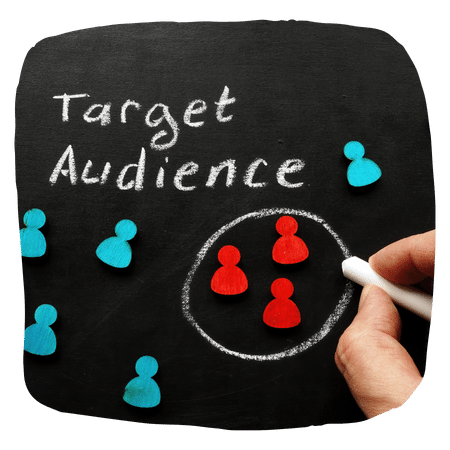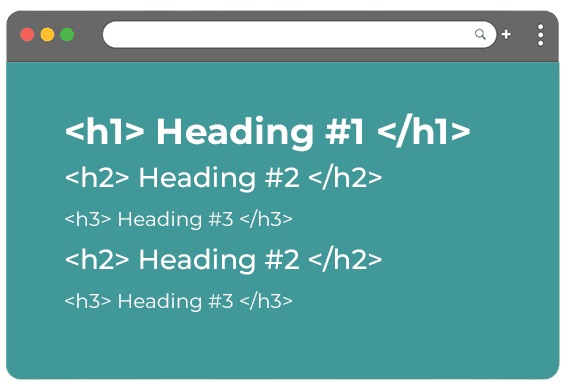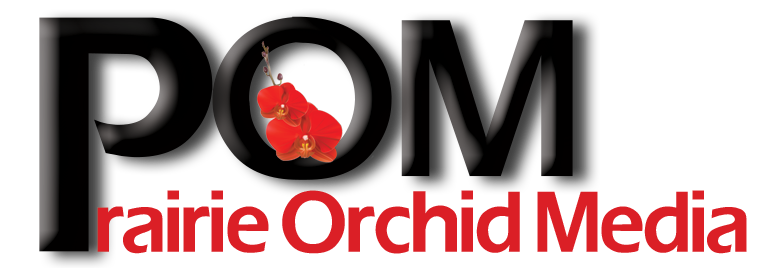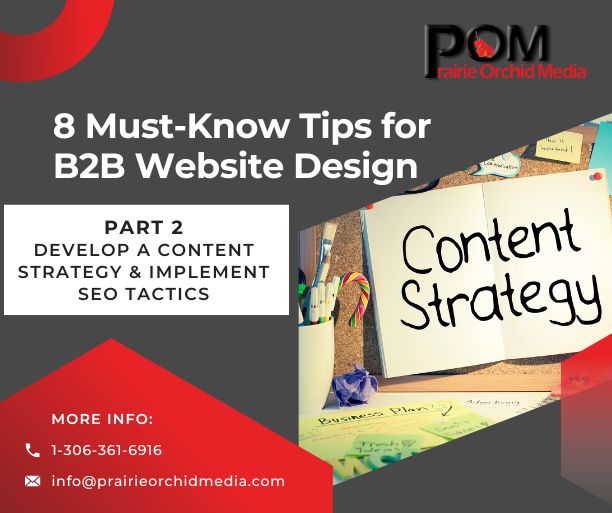Welcome back to part two of our 8 Must-Know Tips for B2B Website Design! Last week we talked about what a B2B website is and how you need to Understand Your Audience and Optimize Navigation. To recap, a B2B website is one that sells to businesses and not consumers. This means that you have to have a content marketing strategy in place, and you should also keep your navigation simple. Need to catch up on last week's blog? Check it out here.
This week we are going to explore the fascinating realm of SEO and web development! We will discuss the importance of Developing a Content Strategy and Implementing SEO Tactics. If you’re looking to skyrocket your website ranking, it’s time to get started building a content strategy and utilizing SEO tactics. By the end of this article, you should have a clear understanding on how optimize your website for success. Get ready, because it’s time to dive into the world of SEO and web development!
Tip #3: Develop a Content Strategy
If you're looking to up your B2B website design game, then developing a content strategy is an absolute must. It's like the icing on the cake, or the sprinkles on top of your ice cream sundae - it just makes everything better! But where do you even begin The first step towards building an engaging website that generates leads is developing a solid content strategy.
Start with keyword research.
This will help you understand what your target audience is searching for and how to tailor your content accordingly. Plus, it'll give you a leg up in the SEO game.
Web development, website design, and SEO are the bread and butter of any business' successful online presence. But before diving into those topics headfirst, we need to understand what keywords our target audience is searching for. By conducting thorough keyword research, we can discover the pain points and interests of our potential customers.
Once we have our list of unique keywords, it's time to get creative with our content creation. Don't just reuse generic information found on every other B2B website out there - give your audience something they can't resist clicking on.
Determine your brand voice and tone.
Your brand voice and tone are crucial aspects of your B2B website design. It's important to determine the tone you want to convey, whether it’s playful or formal, so that your website can be consistent with your brand personality. You should also consider the audience you’re targeting when determining your brand voice and tone. For instance, if you’re targeting a younger demographic, being playful and quirky may be more appropriate than a buttoned-up approach.
Consistency is key when it comes to conveying your brand voice and tone on your B2B website. If visitors come across inconsistency in the language used throughout your website, they may not trust in your company's professionalism or even worse - think it's fake news! To ensure consistency in language usage sit with other writers/designers from time to time for review meetings where everyone can share their ideas regarding what worked best for them while drafting content/ designing visuals etc., then take into account feedback received before proceeding further.
Create a customer persona.
 One of the most crucial steps in creating a successful B2B website is understanding your target audience. To achieve this, it's essential to create a persona that accurately represents your ideal customer. A persona is a fictional character that embodies the traits and characteristics of your typical customer.
One of the most crucial steps in creating a successful B2B website is understanding your target audience. To achieve this, it's essential to create a persona that accurately represents your ideal customer. A persona is a fictional character that embodies the traits and characteristics of your typical customer.
To create an effective persona, you need to gather as much information as possible about your customers' demographics, psychographics, behaviors, and pain points. You can then use this data to develop a detailed profile that includes aspects such as their age range, job title, buying habits, goals and objectives.
By having a clear understanding of who your target audience is through personas' creation, you'll have the foundation to design an effective website that resonates with them. Websites designed with well-crafted personas in mind will increase engagement rates and conversions while reducing bounce rates by providing relevant content tailored explicitly for them.
Create a content calendar.
Creating a content calendar is an essential part of any successful B2B website design strategy. Since you already identified your target audience, this will help you create a plan that caters specifically to their needs and interests. You can then decide on the frequency of publication, such as daily, weekly, or monthly.
You need to know what you're going to publish, when you're going to publish it and what the ultimate goal is for each piece of content. If you're creating a lot of content, it can be easy to lose track of what you've published and when. By using a content calendar, you'll be able to keep your brand's message on-brand and consistent across all of your channels.
 The next step is setting up a schedule for each piece of content you plan to publish. This includes assigning deadlines for writing, editing, and publishing the content. It’s important to keep in mind the ultimate goal for each piece, whether it’s generating leads, increasing brand awareness or educating your audience.
The next step is setting up a schedule for each piece of content you plan to publish. This includes assigning deadlines for writing, editing, and publishing the content. It’s important to keep in mind the ultimate goal for each piece, whether it’s generating leads, increasing brand awareness or educating your audience.
Google's algorithms prioritize websites with high-quality, authoritative content. Aim to create informative, engaging blog posts and other types of content that provide value to your target audience while incorporating relevant keywords naturally throughout the text.
Finally, don’t forget to track your results and adjust your calendar accordingly over time. Pay close attention to which pieces perform well and which ones fall short so you can make informed decisions about future content creation. By creating a solid content calendar from the start, you’ll be able to stay organized and on track with your overall marketing goals while delivering valuable information to your target audience.
Test, test and test some more.
When it comes to B2B website design, testing is crucial. It's important to test your website on different devices and browsers to ensure that it looks and functions properly across all platforms. This includes mobile responsiveness, which is becoming increasingly important as more people access the internet through their smartphones.
Testing also allows you to identify any bugs or issues that may be affecting the user experience. By catching these problems early on, you can make necessary adjustments before they become major issues for your customers. In addition, testing can give you insights into what is working well on your website and what isn't, allowing you to make data-driven decisions about future updates and improvements.
Overall, testing should be an ongoing process throughout the lifespan of your B2B website. By continuously monitoring and adjusting your site based on feedback from users and analytical data, you can improve its effectiveness and ensure a positive experience for all visitors.
Tip #4: Implement SEO Tactics
One important aspect of B2B website design is implementing effective SEO tactics. This involves optimizing your website's content and structure to improve its ranking in search engine results pages (SERPs). To achieve this, you need to understand the keywords that your target audience is searching for and incorporate them into your website's copy and meta tags.
Use Long-tail Keywords
Long-tail keywords are longer, more specific phrases that people use when they're closer to making a purchase. Including these in your website content can help you rank higher in search engine results pages (SERPs) and attract more qualified visitors. Including long-tail keywords in your website content is crucial for B2B companies. These longer, more specific phrases help to target customers who are closer to making a purchase decision. By incorporating these keywords into your website copy and blog posts, you increase the chances of attracting high-quality traffic and potential leads.
One way to find relevant long-tail keywords is by conducting keyword research using tools like Google Keyword Planner or SEMrush. These tools allow you to identify commonly used search terms that relate to your business and industry. You can then incorporate these phrases naturally into your website content, ensuring that they fit seamlessly with the overall messaging of your site.
Another benefit of using long-tail keywords is that they can help improve your search engine rankings. Since these phrases are more specific, there is typically less competition for them than for shorter, broader keywords. This means that including targeted long-tail keywords in your content can help you rank higher on search engine results pages (SERPs) for those particular phrases, increasing visibility and driving more qualified traffic to your site.
Optimize Your Meta Tags
 Your meta tags are the snippets of text that appear in SERPs under your page title. They include the meta title and description, which should be optimized to accurately reflect the content on each page while also including relevant keywords.
Your meta tags are the snippets of text that appear in SERPs under your page title. They include the meta title and description, which should be optimized to accurately reflect the content on each page while also including relevant keywords.
-
Meta tags are an essential component of your B2B website design because they help search engines understand the purpose and content of your page. The meta title appears as the headline in SERPs, while the meta description provides a brief summary of what users can expect to find on your page.
-
To optimize your meta tags, you should include relevant keywords that accurately reflect the topic or theme of your page. You should also aim to create compelling and unique descriptions that entice users to click through to your site.
-
In addition to optimizing for search engines, it's important to keep in mind that these snippets will be the first impression potential customers have of your business. A well-crafted meta tag can increase clicks and drive traffic to your site, so take the time to carefully craft each one.
-
It's also worth noting that while there is no specific character limit for meta titles or descriptions, Google typically displays only up to 60 characters for titles and 160 characters for descriptions in its search results pages (SERPs). Keep this in mind when crafting your tags so you can ensure they are fully displayed in search results.
-
Overall, incorporating well-optimized meta tags into your B2B website design strategy is a simple yet effective way to improve visibility and attract more traffic from search engines. By choosing relevant keywords and crafting compelling descriptions, you can make sure potential customers see exactly what they're looking for when searching online.
Build Quality Backlinks
Backlinks – links from other websites pointing to yours – can significantly boost your SEO efforts if they come from reputable sources within your industry or niche.
Backlinks are one of the most important factors in SEO. They help search engines understand how relevant and trustworthy your website is. Backlinks from reputable sources within your industry can significantly boost your SEO efforts, as they show that other websites consider your content to be valuable and worth linking to.
However, not all backlinks are created equal. It's important to ensure that the sites linking to yours are high-quality and relevant to your industry. Google penalizes websites with low-quality or spammy backlinks, so it's crucial to only seek out links from reputable sources.
One effective way to get high-quality backlinks is through guest blogging on other websites within your industry. This allows you to showcase your expertise while also providing value for the host website's audience. Additionally, building relationships with other businesses in your industry can lead to natural backlinking opportunities as they may link to you in their own content without being asked.
Use Header Tags Properly
 Header tags (H1-H6) help organize webpage content and make it easier for search engines and readers alike to understand what each section is about.
Header tags (H1-H6) help organize webpage content and make it easier for search engines and readers alike to understand what each section is about.
Header tags are an essential tool for organizing webpage content, especially for B2B website design. They allow you to break up your content into sections and give each section a clear title that summarizes its main purpose or theme. This helps readers quickly scan your pages to find the information they need without having to read through blocks of text.
Additionally, header tags provide a hierarchy of information that search engines can use to understand the structure and importance of your page content. By using H1 tags for the main title of your page, followed by H2 tags for section headings and so on, you signal to search engines which parts of your content are most important.
However, it's important not to overuse header tags or use them inappropriately just because they look good on a page. The primary purpose of header tags is to help organize and structure content, not just make it look more visually appealing. So be sure to use them wisely and follow best practices when incorporating them into your B2B website design strategy.
Optimize Images for SEO
Large image files can slow down page load times, which negatively impacts user experience and SEO rankings as a result. One of the most important factors in B2B website design is page load time. Large image files can significantly slow down page loading speed, which can be detrimental to user experience and SEO rankings. Users tend to lose patience quickly when a webpage takes too long to load, and they are likely to leave the site altogether if it takes more than a few seconds.
In addition, Google's algorithms take into account page speed as a ranking factor for search results. Slow-loading pages may result in lower visibility on search engine results pages (SERPs), leading to fewer clicks and less traffic overall. To address these issues, website designers should optimize images for web use by compressing them properly without sacrificing quality or resolution.
Ensure Mobile Responsiveness
With Google's mobile-first indexing algorithm now fully implemented, having a mobile-responsive website is crucial for both user experience and SEO success. We're not going to go into huge detail about this now because we're going to go into more detail next week's blog.
In conclusion, implementing the tips mentioned for B2B website design can significantly improve your chances of attracting and converting potential clients. It is important to keep in mind that a successful website should be user-friendly, visually appealing, and informative. Utilizing visual aids such as images or videos can help provide more context to your products or services. Regularly updating and maintaining your website can help ensure its performance and enhance its online presence. By following these essential tips for B2B website design, businesses can create a powerful online platform that represents their brand effectively while catering to the needs of their target audience.
Make sure to watch next week when we'll be uncovering two more helpful tips - it's not one to miss out on!
Thanks for being part of the Prairie Orchid Media community, and we look forward to helping you reach your website goals this year. We offer a wide range of web development and design services to help businesses increase their web presence.



